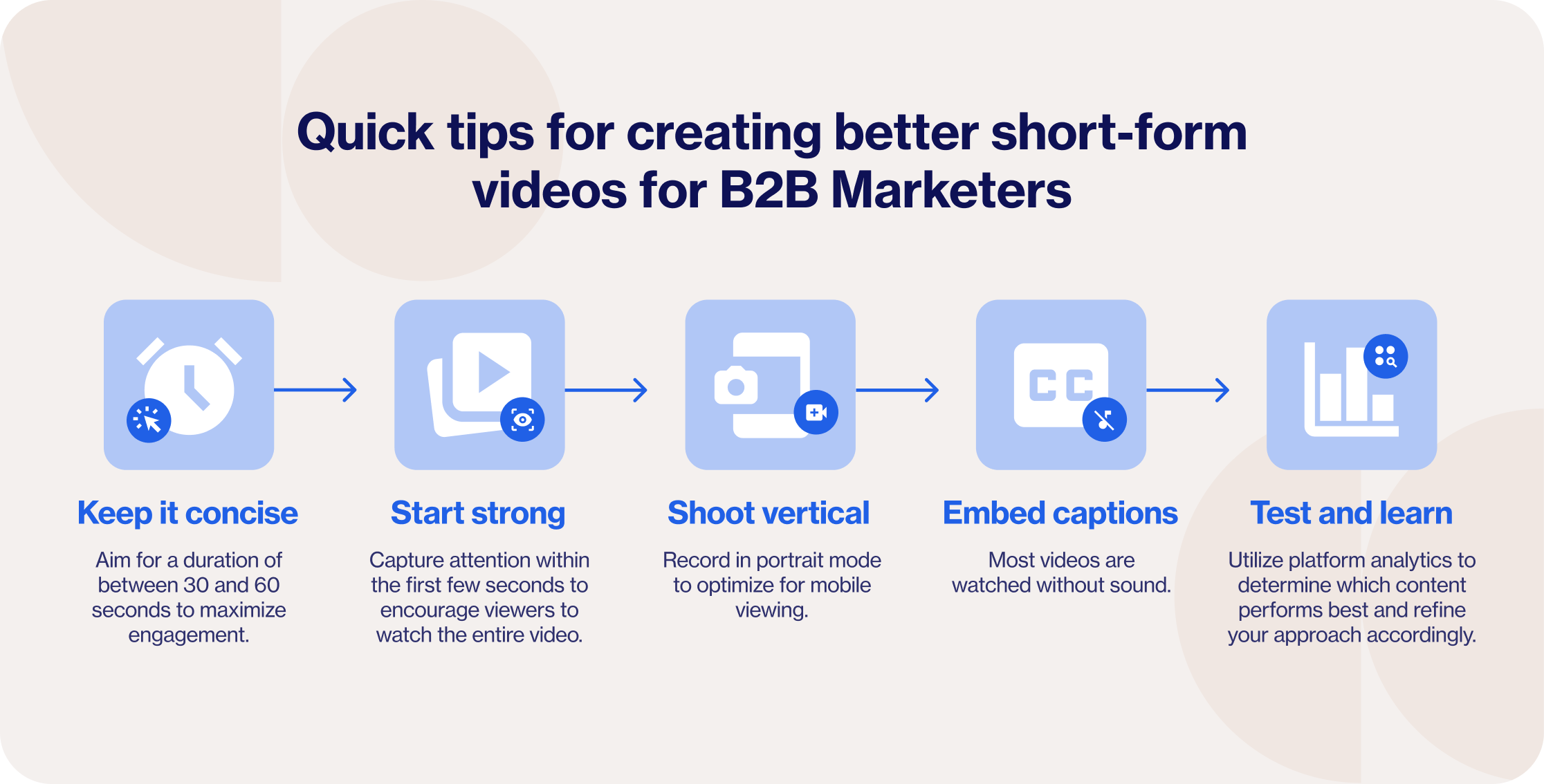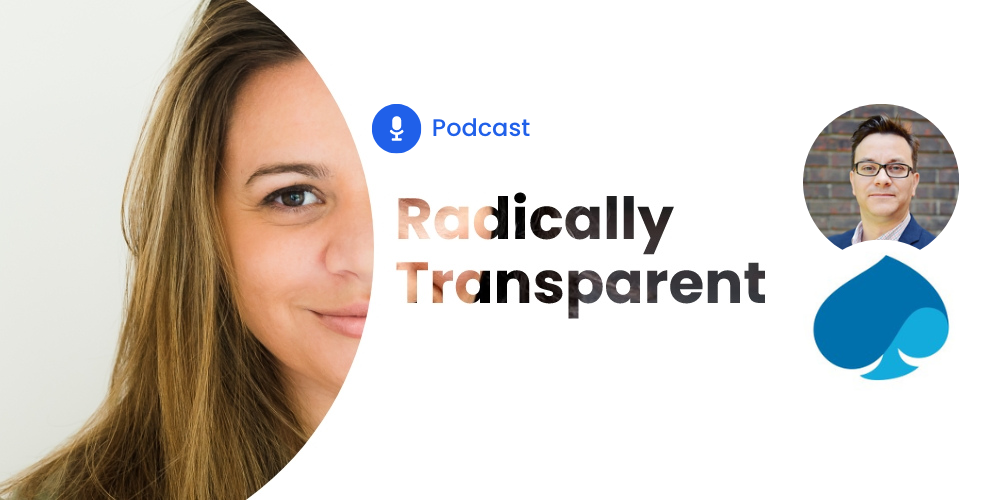How short-form video is changing B2B social media in 2025

Table of contents
The short-form takeover. Tiktokification. It has many names, and it has no shortage of detractors. But you know what this phenomenon is, without any explanation. And it’s the most critical trend for your social media marketing team to understand and master in 2025.
Short-form video is dominating the scroll. As a genre, it was refined on TikTok. Still, it has long since broken free and impacted every other platform, including LinkedIn, Instagram, Facebook, and even the king of video, YouTube.
For B2B marketers, this presents an incredible opportunity, albeit one that is wrapped up in a technical challenge. Every platform now prioritizes video content differently. That means there’s no one-size-fits-all approach. It also means there’s no shortage of ways to stand out when you play to each platform’s strengths.
The first question to ask is: Where do I start? What should I post?
From there, the more critical question is: How do I tailor video formats to each channel?
In this article, we’re providing an answer to all of them and giving you some actionable advice you can build into your next video brief.
Why short-form video is dominating social media
Long-form written content isn’t going away. But the rise of short-form video has forced it to share the spotlight. In today’s attention economy, short-form video is how your audience connects (It’s increasingly how they convert, too).
It started with Instagram. Some readers may recall it as a photo-first app, before it pivoted to video in response to TikTok’s meteoric rise. TikTok’s new format reshaped how people consume content altogether. Everything became fast, dynamic, and ultra-personalized, conditioning users to expect constant movement and instant relevance.
Instagram answered with Reels. YouTube countered with Shorts. LinkedIn began to prioritize native video, recognizing its power to drive engagement and visibility. The shift from static to motion content followed the shortening of attention spans. Audiences now expect value in under a minute. Surveys consistently show that users prefer shorter videos to longer ones, and that preference gap is widening.
Platform-by-platform breakdown: How to tailor your B2B video strategy
LinkedIn: the B2B video slow-burner
A latecomer to the video-first race, LinkedIn has quietly become a fertile ground for short-form thought leadership and professional storytelling.
- Supports square and vertical videos that autoplay in-feed. Captioning is important because most LinkedIn users are viewing these videos without audio.
- Native uploads receive algorithmic preference, especially when they feature real people, rather than polished brand videos.
- Best for: Personal commentary from execs, quick industry insights, or behind-the-scenes team moments that build trust and credibility.
Facebook & Instagram: Meta’s twin engines of reach
Instagram and Facebook Reels now operate as an interconnected ecosystem, making cross-platform video sharing seamless and high-impact.
- Reels and Stories are central discovery tools, with strong algorithmic reach for consistent video creators.
- Cross-posting boosts exposure and makes content more efficient to produce and distribute.
- Best for: Visually engaging product explainers, team culture clips, and fast tips that fit the platform’s polished, friendly aesthetic.
YouTube: the original video giant goes short
YouTube Shorts was built to compete with TikTok, but it brings a unique edge: discoverability through search and the ability to funnel viewers to longer content.
- Shorts have over 50 billion daily views and are a key growth lever for creators and brands.
- Optimized for SEO and channel growth, Shorts can bring new subscribers and reinforce long-form content.
- Best for: Educational how-tos, mini case studies, and clipped highlights from webinars or longer videos.
X: the minimalist
X supports video, but discovery is limited, and content tends to disappear quickly. Still, it’s valuable for real-time takes and reactions.
- Videos can be embedded or uploaded, but lack the immersive playback experience of other platforms.
- Limited searchability and a short shelf life make it better suited for commentary than for evergreen content.
- Best for: Quick soundbites, event reactions, or links to richer content hosted elsewhere.
For B2B marketers managing all of this, usability and results vary. Video formats thrive where platforms prioritize visual storytelling and reward consistency. Companies like Zillow and Shopify have leveraged Shorts and Reels to break down complex topics into snackable, relatable content, something any B2B SaaS brand can learn from.
Recommended for further reading
What B2B marketers need to know in 2025
Your buyers are also consumers, and they scroll through social media with the same habits they use for personal content. This means your product needs an approachable, engaging intro (no matter how complex it is). Some ways to do this include:
- A 15-second explainer (easier said than done).
- Snippets of your CEO and other Execs explaining a customer pain point.
- Quick demo walkthroughs that actually show the product in action.
- Quick snippets of the recording of your engaging podcast
- Quick quotes from the webinar you just hosted
Your goal is to grab and then hold viewers’ attention, and to do it instantly. By instantly, we mean: within the first 3 seconds. For viewers, the right hook can be the difference between going unnoticed and gaining a follow from a decision maker.
Scaling your video strategy with Oktopost
Short-form video was once a B2C trend, but it has become a standard in B2B. For marketers who want to stand out and stay relevant, understanding the nuances of each platform is no longer optional.
But adapting your video strategy for every platform doesn’t have to mean more stress.
For B2B marketers who want to leverage multiple platforms and overcome evolving formats, Oktopost simplifies social video planning, publishing, and analytics. From one centralized dashboard, you can:
- Tailor content to platform-specific video specs.
- Schedule short-form clips across multiple channels.
- Measure engagement and ROI down to the social click.
- Empower employees to share brand videos via advocacy tools.
With Oktopost, your video strategy scales with your ambitions, not your workload. If you’re eager to make short-form video work for B2B, make Oktopost your control center.
Quick tips for better short-form B2B videos

Like many B2B marketers, you may still be getting your bearings with short-form video. Here’s a snapshot of what defines this fast-growing format and how to make it work for your brand.
Length
Short-form content is typically under 10 minutes, but the sweet spot for engagement is often between 30 and 60 seconds.
Format
Vertical (portrait-mode) videos dominate, as most viewers are on mobile devices.
Engagement style
These videos are made to be instantly consumable. Aim for fast, punchy, and visually sticky.
Platforms to know
TikTok, Instagram Reels, and YouTube Shorts lead the way in reach and adoption.
Why marketers love it
It’s a fast way to showcase products, messages, or moments, especially for building brand awareness and engagement.
Growing by the day
Short-form video is gaining traction across all age groups, with daily consumption on the rise.




